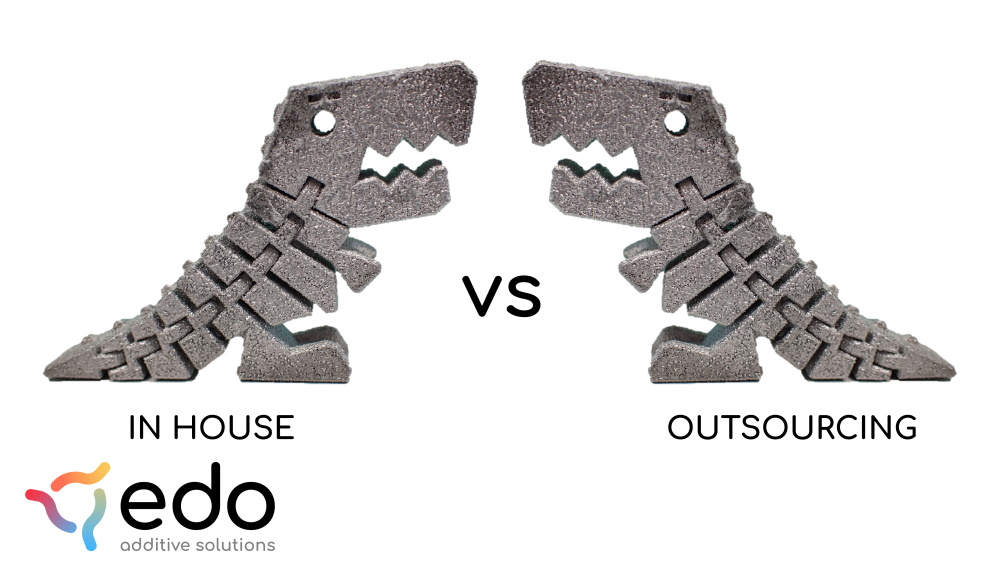3D Printing In-house vs Contract Manufacturing

Introduction
Choosing between in-house 3D printing and contract manufacturing depends on various factors, and each option has its own advantages and drawbacks. With this article, we want to provide you with some points to consider before deciding what model fits you best. We would love to give you a short answer on what you should do, but the reality is that this decision needs to be made based on an in-depth analysis of the company, the situation today and tomorrow and the needs and visions. We can help you with our expertise in that decision-making process not only in the form of that article but also in the form of consulting and engineering specifically tailored to your situation and needs.

In-house manufacturing or outsourcing 3D printing? Not an easy choice (Metal 3D Printed Model: print3D-FlexiRex by DrLex0 on GitHub – CC BY-SA)
1 What do you plan to print?
Are you planning to use additive manufacturing mainly in R&D, or printing repair parts or full-scale production? Are you planning on printing only one material, or will you be printing different materials with maybe even different technologies? Depending on your use case, the required machines may differ significantly and therefore, the feasibility and economically will differ hugely.
2 Speed and Time-to-Market
Think about the lead times you require for your parts. Do you need your parts usually as soon as possible, or is it okay to get them in some week’s time? Also how fast do you want to start with 3D Printing? Do you want to get the first parts printed in days and weeks, or is it fine to get started with production only in a few months? Starting your own production usually takes some time and investment in the beginning to set up. However it can reduce your long term lead times from 2-6 weeks down to only 2-5 days.
3 Flexibility
You need to ask yourself, do you need high production flexibility to accommodate fast-changing market conditions where demand can spike and drop? Then you might want to go with contract manufacturing since contract manufacturers can usually better accommodate those fluctuations since they usually have larger machine parks with many customers which balances out. If you have huge fluctuations in your own production, you might need new employees and machines, which takes time. Also, think about the financial flexibility that you lose with in-house production.
4 Process control, IP and company strategy
Depending on what your company does, it might be beneficial to have a production in-house so that the development teams can directly work together with the production to get the most out of the machines and the technology. An in-house production might be safer from an intellectual property (IP) standpoint. Also, think about the overall strategy of your company. Is the strategy targeting and manufacturing everything in-house, or to focus on the core of the business and outsource all noncore tasks?
5 Cost
When you have a clear idea about the first four points, you can think about cost. Only by that point do you know what you need and what you don’t need. Therefore, you can choose machines and estimate the cost of in-house vs contract manufacturing. Usually in-house manufactured parts are less expensive, but it very much depends on factors like your machine utilisation. At that point, it is also important to take into account your labour, post processing cost as well as already existing machines and many more factors to get a good overview.
Bonus: Global Reach
Think about where your customers are. Depending on where you are and where your customers are, it might make sense to use 3D printing farms closer to your customers to reduce lead times and shipping costs (yes, the cost analysis can get complex for a comprehensive image) and ultimately your CO2 footprint by manufacturing locally. Also, this way, your parts can’t get stuck at the airport or in the Suez Canal.
Conclusion
The decision of in-house vs contract manufacturing is a difficult one, but luckily, it is also not an absolute and finite decision. There are intermediate ways where some of the production is in-house while some is outsourced.
We can answer our questions about Additive Manufacturing, give courses on AM topics, design your parts and find the right applications for 3D printing in your company. Just give us a call or write us here, and don’t forget to subscribe to our newsletter.
The next releases will cover:
- How to Find the Right 3D Printing Process
- High-resolution 3D Printing (SLA/DLP)
- Holistic Benefits of 3D Printed Parts
- Low Quantity Parts / Replacement Parts with 3D Printing
- 3D Printed Waveguides
Subscribe to our newsletter to learn more about additive manufacturing.